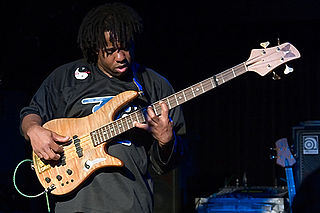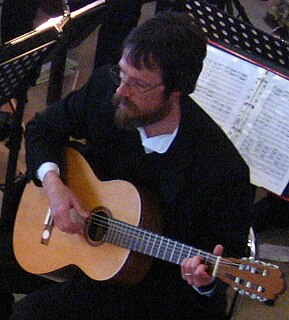
Bass ( BAYSS) describes tones of low (also called "deep") frequency, pitch and range from 16 to 256 Hz (C0 to middle C4) and bass instruments that produce tones in the low-pitched range C2-C4. They belong to different families of instruments and can cover a wide range of musical roles. Since producing low pitches usually requires a long air column or string, and for stringed instruments, a large hollow body, the string and wind bass instruments are usually the largest instruments in their families or instrument classes.

Figured bass, or thoroughbass, is a kind of musical notation in which numerals and symbols indicate intervals, chords, and non-chord tones that a musician playing piano, harpsichord, organ, lute play in relation to the bass note that these numbers and symbols appear above or below. Figured bass is closely associated with basso continuo, a historically improvised accompaniment used in almost all genres of music in the Baroque period of Classical music (c.1600–1750), though rarely in modern music.
Sheet music is a handwritten or printed form of music notation that uses modern musical symbols to indicate the pitches (melodies), rhythms or chords of a song or instrumental musical piece. Like its analogs – printed books or pamphlets in English, Arabic or other languages – the medium of sheet music typically is paper, although the access to musical notation since the 1980s has included the presentation of musical notation on computer screens and the development of scorewriter computer programs that can notate a song or piece electronically, and, in some cases, "play back" the notated music using a synthesizer or virtual instruments.

Alberti bass is a particular kind of accompaniment figure in music, often used in the Classical era, and sometimes the Romantic era. It was named after Domenico Alberti (1710–1740/46), who used it extensively, although he was not the first to use it.

A chord, in music, is any harmonic set of pitches consisting of three or more notes that are heard as if sounding simultaneously.

A bassline is the term used in many styles of music, such as jazz, blues, funk, dub and electronic, traditional music, or classical music for the low-pitched instrumental part or line played by a rhythm section instrument such as the electric bass, double bass, cello, tuba or keyboard. In unaccompanied solo performance, basslines may simply be played in the lower register of any instrument such as guitar or piano while melody and/or further accompaniment is provided in the middle or upper register. In solo music for piano and pipe organ, these instruments have an excellent lower register that can be used to play a deep bassline. On organs, the bass line is typically played using the pedal keyboard and massive 16' and 32' bass pipes.

Accompaniment is the musical part which provides the rhythmic and/or harmonic support for the melody or main themes of a song or instrumental piece. There are many different styles and types of accompaniment in different genres and styles of music. In homophonic music, the main accompaniment approach used in popular music, a clear vocal melody is supported by subordinate chords. In popular music and traditional music, the accompaniment parts typically provide the "beat" for the music and outline the chord progression of the song or instrumental piece.
Seventh is the ordinal form of the number seven.

In music, a ninth is a compound interval consisting of an octave plus a second.

In music or music theory, a thirteenth is the interval between the sixth and first scale degrees when the sixth is transposed up an octave, creating a compound sixth, or thirteenth. The thirteenth is most commonly major Play (help·info) or minor Play (help·info).
A fake book is a collection of musical lead sheets intended to help a performer quickly learn and perform new songs. Each song in a fake book contains the melody line, basic chords and sometimes lyrics – the minimal information needed by a musician or small group to make an extemporized arrangement of a song, or "fake it". The fake book is a central part of the culture of playing music in jazz, where strong improvisation abilities are expected from "comping" rhythm section players and "lead instruments" which play the melody and improvise lengthy solos over the chord progression.
A rhythm section is a group of musicians within a music ensemble or band who provide the underlying rhythm, harmony and pulse of the accompaniment, providing a rhythmic and harmonic reference and "beat" for the rest of the band.
Bass or Basses may refer to:
A broken chord is a chord broken into a sequence of notes. A broken chord may repeat some of the notes from the chord and span one or more octaves.
In popular music, a fill is a short musical passage, riff, or rhythmic sound which helps to sustain the listener's attention during a break between the phrases of a melody. "The terms riff and fill are sometimes used interchangeably by musicians, but [while] the term riff usually refers to an exact musical phrase repeated throughout a song", a fill is an improvised phrase played during a section where nothing else is happening in the music. While riffs are repeated, fills tend to be varied over the course of a song. For example, a drummer may fill in the end of one phrase with a sixteenth note hi-hat pattern, and then fill in the end of the next phrase with a snare drum figure.
The second inversion of a chord is the voicing of a triad, seventh chord, or ninth chord in which the fifth of the chord is the bass note. In this inversion, the bass note and the root of the chord are a fourth apart which traditionally qualifies as a dissonance. There is therefore a tendency for movement and resolution. In notation form, it is referred to with a c following the chord position or as a 6
4 chord.
Jazz improvisation is the spontaneous invention of melodic solo lines or accompaniment parts. It is one of the defining elements of jazz. Improvisation is composing on the spot, when a singer or instrumentalist invents melodies and lines over a chord progression played by rhythm section instruments and accompanied by drums. Although blues, rock, and other genres use improvisation, it is done over relatively simple chord progressions which often remain in one key.
In music theory, the word inversion has distinct, but related, meanings when applied to intervals, chords, voices, and melodies. The concept of inversion also plays an important role in musical set theory.

The Elektra chord is a "complexly dissonant signature-chord" and motivic elaboration used by composer Richard Strauss to represent the title character of his opera Elektra that is a "bitonal synthesis of E major and C-sharp major" and may be regarded as a polychord related to conventional chords with added thirds, in this case an eleventh chord. It is enharmonically equivalent to a 7#9 chord : D♭-F-A♭-C♭-E.

Baroque music is a period or style of Western art music composed from approximately 1600 to 1750. This era followed the Renaissance music era, and was followed in turn by the Classical era. Baroque music forms a major portion of the "classical music" canon, and is now widely studied, performed, and listened to. Key composers of the Baroque era include Johann Sebastian Bach, Antonio Vivaldi, George Frideric Handel, Claudio Monteverdi, Domenico Scarlatti, Alessandro Scarlatti, Henry Purcell, Georg Philipp Telemann, Jean-Baptiste Lully, Jean-Philippe Rameau, Marc-Antoine Charpentier, Arcangelo Corelli, Tomaso Albinoni, François Couperin, Giuseppe Tartini, Heinrich Schütz, Giovanni Battista Pergolesi, Dieterich Buxtehude, and Johann Pachelbel.











